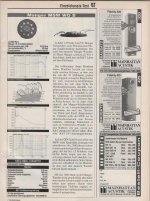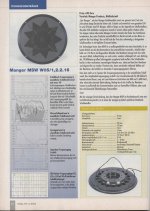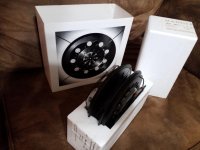Be unbelievably careful with these... if you don't completely cut out the low frequencies the cone will bottom out, severing the voice coil leads like I did with mine.
Would you happen to have not thrown away the center damping plug? i'mn missing mine...
Sorry, but it all went in the bin, and gone to the dump.
Willem.
i myself heard manger once. and cant say i was impressed.
That's exactly what the MSW is about, in a good way. It just reproduces the audio without adding special effects that stand out.
I have manger zerobox 109s but re-engineered the crossovers and changed the MSW compartment dampening. This transformed them and they sound significantly better than stock.
The main things the MSW needs to work properly is the correct enclosure volume and cabinet dampening along with a crossover point no lower than 600 hz 2nd order or 900 hz 1st order (this was my choice to retain perfect pulse response). With a good woofer, there is no deficit in resolution or accuracy compared to the low stock crossover point used in the zero zerobox 109. If anything, its improved in regards to dynamic capabilities and power handling, allowing the MSW to come alive.
You will ruin the sound and suck the life out of the midrange from the MSW if you just simply stuff the enclosure. The driver is incredibly sensitive to where and how far you place the dampening material in relation to the rear surface of the MSW. That annoying 1k-ish resonance can be reduced to a negligible level by careful placement and proper amount of dampening material. Troelsgraven harps on this in his review and doesn't consider this being a possible influence despite Manger emphasizing the importance of correct dampening and the midrange frequency performance of the MSW.
Yes, the off axis HF is an issue if you are the type of guy who likes wide dispersion and wants to listen outside of the sweet spot. It honestly doesn't bother me and the sweet spot isn't that small for my preference.
The MSW sound is effortless and transparent. Don't let people's opinions keep you from discovering the sound of these drivers. The only thing that pops up on Google is the Troels review which isnt the whole story, plus the drivers he reviewed have black paint over-spray all over the dampening foam star - go to his site and see for yourself. Troels is a smart guy and great speaker designer, but his MSW review isn't completely applicable.
The main things the MSW needs to work properly is the correct enclosure volume and cabinet dampening along with a crossover point no lower than 600 hz 2nd order or 900 hz 1st order (this was my choice to retain perfect pulse response). With a good woofer, there is no deficit in resolution or accuracy compared to the low stock crossover point used in the zero zerobox 109. If anything, its improved in regards to dynamic capabilities and power handling, allowing the MSW to come alive.
You will ruin the sound and suck the life out of the midrange from the MSW if you just simply stuff the enclosure. The driver is incredibly sensitive to where and how far you place the dampening material in relation to the rear surface of the MSW. That annoying 1k-ish resonance can be reduced to a negligible level by careful placement and proper amount of dampening material. Troelsgraven harps on this in his review and doesn't consider this being a possible influence despite Manger emphasizing the importance of correct dampening and the midrange frequency performance of the MSW.
Yes, the off axis HF is an issue if you are the type of guy who likes wide dispersion and wants to listen outside of the sweet spot. It honestly doesn't bother me and the sweet spot isn't that small for my preference.
The MSW sound is effortless and transparent. Don't let people's opinions keep you from discovering the sound of these drivers. The only thing that pops up on Google is the Troels review which isnt the whole story, plus the drivers he reviewed have black paint over-spray all over the dampening foam star - go to his site and see for yourself. Troels is a smart guy and great speaker designer, but his MSW review isn't completely applicable.
Quad ESL57 does not measure well today's standards too but tonality and musicality is great. Measurements are not everything.
They measure better than many modern systems (I'm looking at you, horn systems), and the distortion is very low. too beamy vertically, and dynamically limited, but I wouldn't go so far as to say doesn't measure well.
SDS Audio Labs - Quad Electrostatic Loudspeaker Measurements
Sheldon
Sheldon -
I looked at the very nicely produced Quad rebuild website and glad to see freq plots and helpful remarks, albeit coming from a commercially motivated source.
But the first thing that struck me in looking at the glamour opening photo is: why is the mic pointing in the wrong direction instead of right-angle to the sound source?
A little goof the photographer made for aesthetic purposes?
B.
I have manger zerobox 109s but re-engineered the crossovers and changed the MSW compartment dampening. This transformed them and they sound significantly better than stock.
The main things the MSW needs to work properly is the correct enclosure volume and cabinet dampening along with a crossover point no lower than 600 hz 2nd order or 900 hz 1st order (this was my choice to retain perfect pulse response). With a good woofer, there is no deficit in resolution or accuracy compared to the low stock crossover point used in the zero zerobox 109. If anything, its improved in regards to dynamic capabilities and power handling, allowing the MSW to come alive.
You will ruin the sound and suck the life out of the midrange from the MSW if you just simply stuff the enclosure. The driver is incredibly sensitive to where and how far you place the dampening material in relation to the rear surface of the MSW. That annoying 1k-ish resonance can be reduced to a negligible level by careful placement and proper amount of dampening material. Troelsgraven harps on this in his review and doesn't consider this being a possible influence despite Manger emphasizing the importance of correct dampening and the midrange frequency performance of the MSW.
Yes, the off axis HF is an issue if you are the type of guy who likes wide dispersion and wants to listen outside of the sweet spot. It honestly doesn't bother me and the sweet spot isn't that small for my preference.
The MSW sound is effortless and transparent. Don't let people's opinions keep you from discovering the sound of these drivers. The only thing that pops up on Google is the Troels review which isnt the whole story, plus the drivers he reviewed have black paint over-spray all over the dampening foam star - go to his site and see for yourself. Troels is a smart guy and great speaker designer, but his MSW review isn't completely applicable.
Thanks for all the info, just curious if you want to share the way you modified the Manger housing and padding.
Kind regards,
Willem.
I'll look for my notes. It was about 10 yrs ago. I can tell you I used a tennis ball suspended about 3 inches from the MSW back and covered it with 1 inch loose sheeps wool. Cabinet walls in back were lined with 2 inch thich PU foam and front inside corners lined with 1 inch foam. Nothing right behind the MSW aside from the wrapped tennis ball. I got the tennis ball trick recommendation from the audio physics madea speaker. I have the original paperwork somewhere regarding the crossover. I did slightly change the LCR notch a bit to flatten out the lower mids.
I used an older gen version of the ZB 109 in Germany working for BR3 radio outside of Munich splicing commercial tapes together. I instantly fell in love with the sound. I called it the un-speaker. That was in th late 80s. I bought my last diy MSW pair from E-Speakers before Manger pulled the plug and stopped selling to diy.
I used an older gen version of the ZB 109 in Germany working for BR3 radio outside of Munich splicing commercial tapes together. I instantly fell in love with the sound. I called it the un-speaker. That was in th late 80s. I bought my last diy MSW pair from E-Speakers before Manger pulled the plug and stopped selling to diy.
Thanks!
As soon as I have them back and start building I'll post it here, always open for recommendations and critic, one man can't know it all!
I look forward to the results of your build. I’ve two pairs of home built speakers, using the Manger. The crossover point is 400Hz, using Hypex nCore amplifiers with linear phase 24dB electronic filters with DSP, crossing over to twin 7” Dayton Esoteric (MTM) and twin Dayton Ultimax UM8-22 sub-woofers. I find that the Manger does not spit or ring like a lot of treble units, so initially it can sound uninspired but it doesn’t lack anything and is very fast with great transient attack when it’s actually there. The music and vocals are very natural and unfatigueing, just like real music and vocals! When I listen to other speakers, they might sound bright and clear initially but you soon find you want to stop listening. This doesn’t happen with the Manger. I would point out that they seem to be sensitive to the enclosure they are in. The enclosure needs to be very stiff, so I’ve used 20mm aluminium for the baffle and marine ply in a laminate construction for a very solid and dense enclosure.

- Home
- Loudspeakers
- Planars & Exotics
- Taking a MANGER MSW apart


